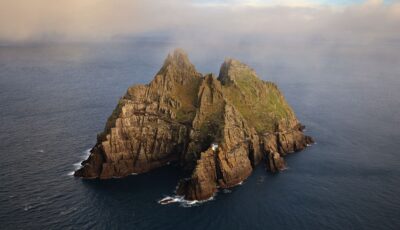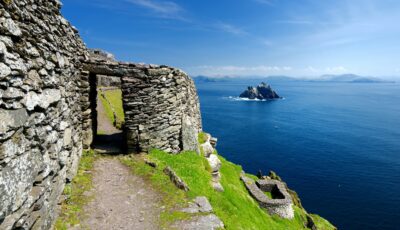The monastic village of Skellig Michael refers to an ancient religious settlement on theisland of Skellig Michael in Ireland.
Perched in one of Ireland’s wildest landscapes, St Fionan’s Monastery is an exceptionalUNESCO World Heritage Site. It is a ruined monastic village built on the steep slopes of Skellig Michael, a deserted island off the Irish coast. It was home to the courageous Irish monks who lived on the island between the 7th and 18th centuries. Stone huts, relics and authentic charm… a fascinating journey into the past!

Skellig Michael – © Valerie O’Sullivan – Failte Ireland
Saint Fionán – sometimes spelled Finan or Fíonán – belongs to that generation of Irish monks born around the VIᵉ century, the men who shaped the first monasteries on Ireland’s southwest coast. He is credited with several foundations in the region, but St Fionan’s Monastery is considered one of his oldest settlements, a place chosen for its isolation conducive to prayer.
Like many Irish saints, Fionán is a figure who navigates between history and legend. It is said that he chose sites where the land broke into the sea, convinced that these extreme landscapes brought man closer to the divine. His monastery is said to have been built in a place where the silence and breath of the elements made every day a time for meditation.
Moreover, the harshness of local life made it a perfect place for introspection and testing one’s faith.
The monastery at St. Fionan’s was not a large stone complex like those developed later. Early Irish monasteries consisted of small, rounded, individual cells of dry stone or wood, accompanied by a larger oratory where the monks gathered.
The rule was simple:
The monks often lived self-sufficiently. The sea, poor soils fertile with wild herbs, a few crops and light livestock supplemented their needs. This frugal lifestyle was reflected in the architecture: stones stacked without mortar, corbelled roofs, circular structures inspired by ancient Celtic huts.

St Fionan’s Monastery, Skellig Michael – © MNStudio
Even today, the simplicity of the construction is striking. The walls are massive, made of large local stones fitted with surprising precision for the time. Parts of the monastery still bear witness to the pre-Romanesque techniques typical of early Christian Ireland.
The oratory – the spiritual heart of the monastery – has a squat, almost defensive silhouette, designed to withstand Atlantic storms. Its orientation is symbolic: the altar faces east, as if welcoming the emerging light. Around it, the remains of the monastic cells can be seen in the form of circles or piles of stones, now covered in lichen and vegetation.
The whole forms a unique spiritual landscape, where the architecture seems to have grown naturally out of the ground.
Monasteries of this era were not only places of prayer. They also served :
St. Gallen Fionan’s Monastery was to play a major role in the gradual Christianization of the Kerry communities. The presence of the saint, renowned for his pedagogical qualities, helped to make the place a spiritual landmark not to be missed.
Like many early monasteries, St Fionan’s Monastery lost its influence over the centuries. The evolution of the Church, invasions and then religious centralization led to the disappearance of many small monastic centers.
Yet the site was never completely forgotten. Local residents continued to regard it as a sacred site, sometimes used for occasional prayers or local blessings. But nature, true to its rhythm, has reclaimed much of the land: crumbling walls, creeping vegetation, stones displaced by frost and bad weather…
Today, this decline reinforces the poetry of the place: we’re not just visiting ruins, but the traces of a spirituality that has endured through time.

St Fionan’s Monastery, Skellig Michael – © MNStudio
Here, the steep slopes of the island of Skellig Michael have remained unchanged for over a thousand years. The wind blows from the same oceans, the stone bears the same lichens and the ruins still obey this primitive, raw and fascinating monastic architecture. For a traveller, this is one of those rare places where nature and history are so intertwined as to become inseparable.
If you visit the site, expect to be immersed rather than on a traditional tour. St. Gallen Fionan’s Monastery is not a restored monument, but an authentic vestige of early Christian Ireland.
The site is set high above the ocean, overlooking Little Skellig, a smaller neighboring island.
To get there, you’ll have to climb an impressive dry-stone staircase built by the monks themselves. (We hope you have stamina: there are 618 steps, some of them slippery and dangerous).
The monastic village of Skellig Michael includes a dozen dry-stone huts, as well as other remains, such as crosses marking graves, low walls and other monastic ruins.
You’ll see:
The atmosphere is conducive to contemplation, photography or simply silent walking.
Visiting this site requires a minimum of preparation. The area can be remote, and access often depends on natural trails.
Here are a few things to keep in mind:
St. Gallen Fionan’s doesn’t ask for tickets or explanations: it simply offers an intimate encounter with a founding part of Ireland.
To explore St Fionan’s Monastery is to touch a primitive Ireland, long before the great stone monasteries you’ll find elsewhere. The site recounts the fervor of solitary monks, the architectural ingenuity inherited from Celtic traditions, and a spirituality deeply rooted in nature.
For a traveler, it’s one of those places that’s both discreet and striking, where the simplicity of the ruins paradoxically becomes what makes the experience memorable.
 Address:
Address: GPS :
GPS :
 Tour duration :
Tour duration :
 Rates :
Rates :